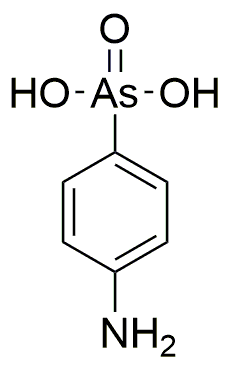4-Aminophenylarsonic acid is widely utilized in research focused on:
- Pharmaceutical Development: This compound is used in the synthesis of various pharmaceuticals, particularly in the development of drugs targeting bacterial infections, due to its antimicrobial properties.
- Agricultural Applications: It serves as a herbicide and pesticide, helping to protect crops from pests and weeds, which is crucial for enhancing agricultural productivity.
- Analytical Chemistry: Researchers employ this compound in analytical methods to detect and quantify arsenic in environmental samples, contributing to pollution monitoring and public health safety.
- Material Science: It is used in the formulation of specialty polymers and materials, providing enhanced properties such as thermal stability and resistance to degradation.
- Biochemical Research: The compound plays a role in studying cellular processes and mechanisms, aiding in the understanding of various biological systems and disease pathways.
General Information
Properties
Safety and Regulations
Applications
4-Aminophenylarsonic acid is widely utilized in research focused on:
- Pharmaceutical Development: This compound is used in the synthesis of various pharmaceuticals, particularly in the development of drugs targeting bacterial infections, due to its antimicrobial properties.
- Agricultural Applications: It serves as a herbicide and pesticide, helping to protect crops from pests and weeds, which is crucial for enhancing agricultural productivity.
- Analytical Chemistry: Researchers employ this compound in analytical methods to detect and quantify arsenic in environmental samples, contributing to pollution monitoring and public health safety.
- Material Science: It is used in the formulation of specialty polymers and materials, providing enhanced properties such as thermal stability and resistance to degradation.
- Biochemical Research: The compound plays a role in studying cellular processes and mechanisms, aiding in the understanding of various biological systems and disease pathways.
Documents
Safety Data Sheets (SDS)
The SDS provides comprehensive safety information on handling, storage, and disposal of the product.
Product Specification (PS)
The PS provides a comprehensive breakdown of the product’s properties, including chemical composition, physical state, purity, and storage requirements. It also details acceptable quality ranges and the product's intended applications.
Certificates of Analysis (COA)
Search for Certificates of Analysis (COA) by entering the products Lot Number. Lot and Batch Numbers can be found on a product’s label following the words ‘Lot’ or ‘Batch’.
Numéro de catalogue
Numéro de lot/série
Certificates Of Origin (COO)
This COO confirms the country where the product was manufactured, and also details the materials and components used in it and whether it is derived from natural, synthetic, or other specific sources. This certificate may be required for customs, trade, and regulatory compliance.
Numéro de catalogue
Numéro de lot/série
Safety Data Sheets (SDS)
The SDS provides comprehensive safety information on handling, storage, and disposal of the product.
DownloadProduct Specification (PS)
The PS provides a comprehensive breakdown of the product’s properties, including chemical composition, physical state, purity, and storage requirements. It also details acceptable quality ranges and the product's intended applications.
DownloadCertificates of Analysis (COA)
Search for Certificates of Analysis (COA) by entering the products Lot Number. Lot and Batch Numbers can be found on a product’s label following the words ‘Lot’ or ‘Batch’.
Numéro de catalogue
Numéro de lot/série
Certificates Of Origin (COO)
This COO confirms the country where the product was manufactured, and also details the materials and components used in it and whether it is derived from natural, synthetic, or other specific sources. This certificate may be required for customs, trade, and regulatory compliance.


